The Intel Skylake-X Review: Core i9 7900X, i7 7820X and i7 7800X Tested
by Ian Cutress on June 19, 2017 9:01 AM ESTBenchmarking Performance: CPU Rendering Tests
Rendering tests are a long-time favorite of reviewers and benchmarkers, as the code used by rendering packages is usually highly optimized to squeeze every little bit of performance out. Sometimes rendering programs end up being heavily memory dependent as well - when you have that many threads flying about with a ton of data, having low latency memory can be key to everything. Here we take a few of the usual rendering packages under Windows 10, as well as a few new interesting benchmarks.
Corona 1.3
Corona is a standalone package designed to assist software like 3ds Max and Maya with photorealism via ray tracing. It's simple - shoot rays, get pixels. OK, it's more complicated than that, but the benchmark renders a fixed scene six times and offers results in terms of time and rays per second. The official benchmark tables list user submitted results in terms of time, however I feel rays per second is a better metric (in general, scores where higher is better seem to be easier to explain anyway). Corona likes to pile on the threads, so the results end up being very staggered based on thread count.
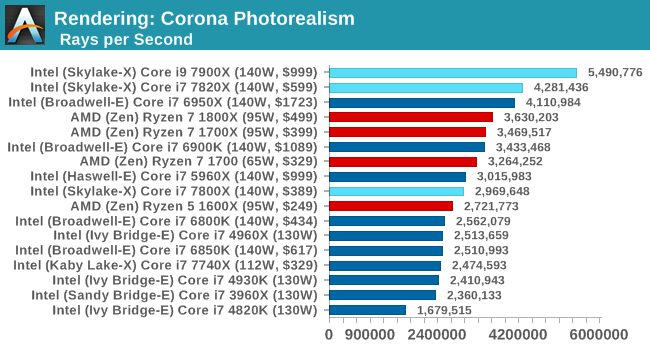
Blender 2.78
For a render that has been around for what seems like ages, Blender is still a highly popular tool. We managed to wrap up a standard workload into the February 5 nightly build of Blender and measure the time it takes to render the first frame of the scene. Being one of the bigger open source tools out there, it means both AMD and Intel work actively to help improve the codebase, for better or for worse on their own/each other's microarchitecture.
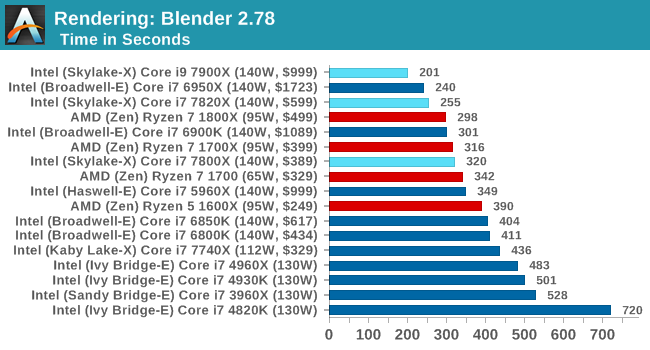
LuxMark
As a synthetic, LuxMark might come across as somewhat arbitrary as a renderer, given that it's mainly used to test GPUs, but it does offer both an OpenCL and a standard C++ mode. In this instance, aside from seeing the comparison in each coding mode for cores and IPC, we also get to see the difference in performance moving from a C++ based code-stack to an OpenCL one with a CPU as the main host.
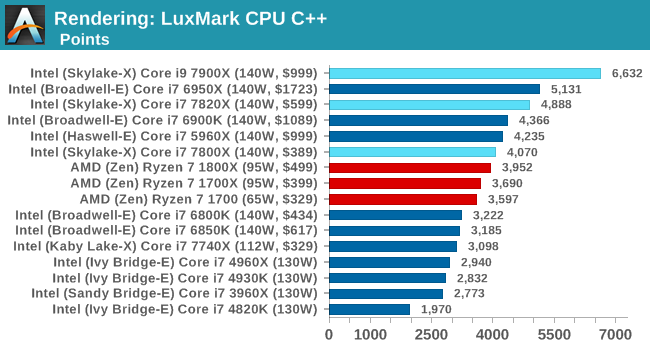
POV-Ray 3.7b3
Another regular benchmark in most suites, POV-Ray is another ray-tracer but has been around for many years. It just so happens that during the run up to AMD's Ryzen launch, the code base started to get active again with developers making changes to the code and pushing out updates. Our version and benchmarking started just before that was happening, but given time we will see where the POV-Ray code ends up and adjust in due course.
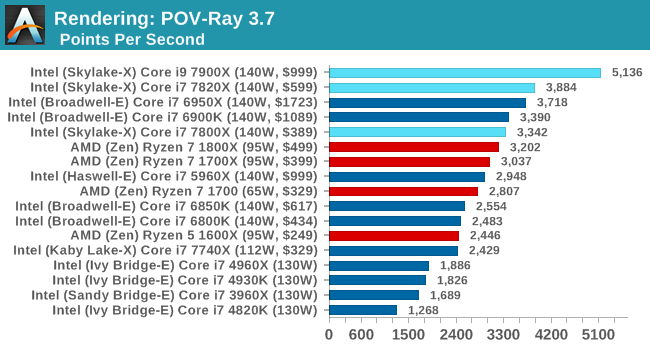
Cinebench R15
The latest version of CineBench has also become one of those 'used everywhere' benchmarks, particularly as an indicator of single thread performance. High IPC and high frequency gives performance in ST, whereas having good scaling and many cores is where the MT test wins out.
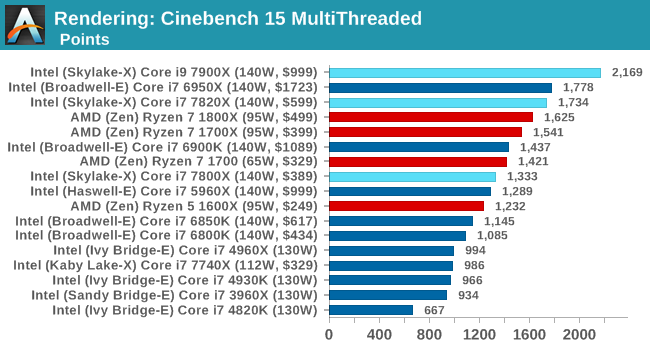
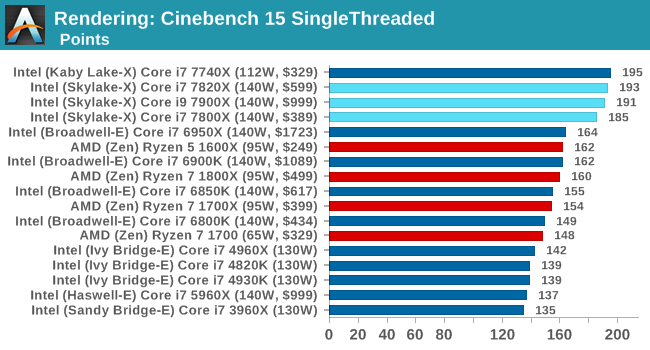










264 Comments
View All Comments
Gothmoth - Tuesday, June 20, 2017 - link
especially in the powerdraw and heat class it dominates even my oven....AntDX316 - Tuesday, June 20, 2017 - link
The new processors are in totally another level/league/class. It dominates in everything and more except a couple benches. If you try to compare by price you can't. It would make no sense.Gothmoth - Tuesday, June 20, 2017 - link
it makes sense.. for everyone except stupid fanboys.Hxx - Tuesday, June 20, 2017 - link
so people are getting pissed because these CPUs perform well albet at a much higher price tag. Sounds like a bunch of AMD fanboys.Its new tech, highest performing, and serving a very niche market. Of course is at a premium price. why wouldn't it be? Luckily, these are not needed for the majority so I am not sure why people get so worked up about it. If you want intel then 7700k is a fantasic $300 CPU. If you want AMD then again the 1700 is also a fantastic CPU. end of story
Gothmoth - Tuesday, June 20, 2017 - link
i personally don´t care about price... my PC´s earn the money back i spend.but saying we can´t compare price/performance form skylake-x and ryzen is just plain stupid.
of course we can.
and we can also compare price/performance when threadripper is released... the real competition to x299.
Gothmoth - Tuesday, June 20, 2017 - link
by the way.. what about the RUMORS that coffee lake will be 6 cores... but no hyperthreading?that would be EXACVTLY what i expect from intel.
Intredpid3d - Tuesday, June 20, 2017 - link
Why did you use Intel's compiler for your reviews? with all the other compilers out there that work beautifully with Ryzen why did you use the one that is known to be deliberately coded to work very badly on anything other than its creators products, Intel.?
johnp_ - Tuesday, June 20, 2017 - link
Were did they use Intel's icc? The Chromium compile test was done using VS Community 2015.3.tamalero - Tuesday, June 20, 2017 - link
Thats the interesting thing, in a lot of reviews online.. there are 3 variations of the same test.1) stock I9 7900
2) optimized compiler I9 7900
3) Oced I9 7900
the optimized one yields like 10% higher on average more performance.
johnp_ - Tuesday, June 20, 2017 - link
2) is not possibly for a Chromium compile test, as that has a hard dependency on Visual Studio 2015 U3 and 3) first requires overclocking, for which they didn't have enough time yet.Regarding higher performance, I expect you mean compiled programs reaching higher performance and not the compilation process requiring less time (which is what anandtech measures here and that's the relevant bit for developers).